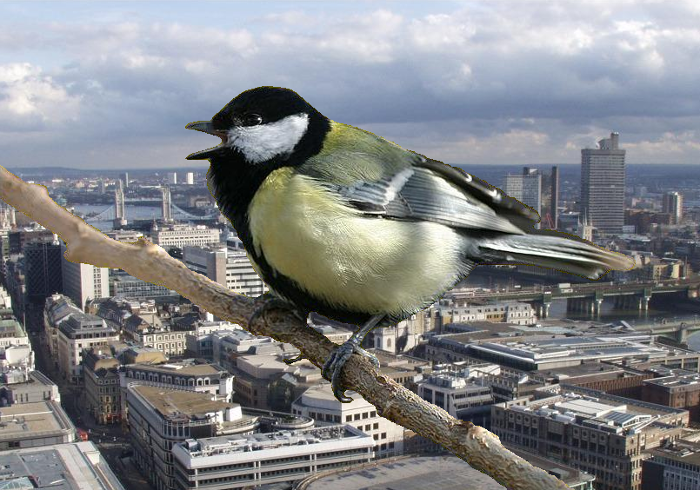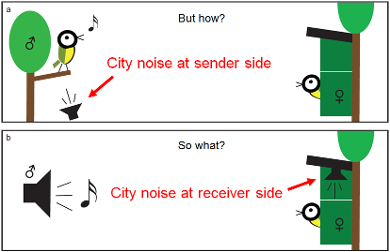Research project
Urban ecology and avian acoustics: Function and evolution of birdsong in a changing world
Birds sing to be heard, but how do they cope with increasing noise levels? Which species persist in cities and why? And do they thrive or suffer in the urban soundscape?
- Duration
- 2003 - 2023
- Contact
- Hans Slabbekoorn
- Funding
-
 The Dutch Research Council (NWO)
The Dutch Research Council (NWO)
-
 Institute of Biology Leiden (IBL)
Institute of Biology Leiden (IBL)
- Partners
Dr. Wouter Halfwerk, Vrije Universiteit Amsterdam (VU)
Dr. Selvino de Kort, Manchester Metropolitan University (MMU)
Dr. Ken Otter, University of Northern British Columbia (UNBC)

Birds typically sing to deter competitors and to attract mates. Acoustically they have to cope with natural obstacles such as vegetation and rocks or buildings. Furthermore, natural soundscapes are increasingly affected by noise from traffic in the air and on the ground and all sorts of industrial and recreational activities. We study how birds cope under noisy conditions: whether they change their singing patterns, whether they still hear and respond to songs of their neighbour, and whether such changes in production or perception of songs affect their reproductive success.
 We started this research with a study published in 2003. MSc-student Margriet Peet had recorded great tits (Parus major) in Leiden and Leiderdorp at quiet and noisy places in the urban environment. She found that birds in territories not far apart vary in the use of song frequencies at the lower end of their range. Birds refrained from using low notes under noisy conditions. This correlation between traffic noise level and song frequency use within a population was repeated among populations throughout Europe in 2006.
We started this research with a study published in 2003. MSc-student Margriet Peet had recorded great tits (Parus major) in Leiden and Leiderdorp at quiet and noisy places in the urban environment. She found that birds in territories not far apart vary in the use of song frequencies at the lower end of their range. Birds refrained from using low notes under noisy conditions. This correlation between traffic noise level and song frequency use within a population was repeated among populations throughout Europe in 2006.
Subsequently, PhD-student Wouter Halfwerk revealed experimentally in 2009 that these correlative patterns are at least partly explained by rapid noise-dependent changes in song type switching and showed effects of noise on reproductive success and intra-pair communication in 2011. We continue to investigate this very suitable and popular model system in our backyard by experimental approaches in the field to study causes and consequences of song variation in urban birds.
Urban birds not only sing differently from their rural counterparts, but also concern a different set of species and maybe also a different set of personalities. Cities are often not less species rich than the surrounding natural habitat types, but the composition is very similar in many cities over vast geographical ranges. We are interested in whether acoustic performance capacity plays a role in the variation in urban success. Urban birds are also reported to be more aggressive relative to nearby birds in the country side. We investigate whether birds of particular personality are more prominent and successful in cities or whether noisy conditions may also annoy birds and make them more aggressive.

- Slabbekoorn, H. & Peet, M. 2003. Birds sing at a higher pitch in urban noise. Nature 424: 267.
- Slabbekoorn, H. & den Boer-Visser, A. 2006. Cities change the songs of birds. Current Biology 16: 2326-2331.
- Slabbekoorn, H. & Ripmeester, E.A.P. 2008. Birdsong and anthropogenic noise: implications and applications for conservation. Molecular Ecology 17: 72-83.
- Halfwerk, W. & Slabbekoorn, H. 2009. A behavioural mechanism explaining noise-dependent pitch shift in urban birdsong. Animal Behaviour 78: 1301-1307.
- Halfwerk, W., Holleman, L. J. M., Lessells, C. M. & Slabbekoorn, H. 2011. Negative impact of traffic noise on avian reproductive success. Journal of Applied Ecology 48: 210-219.
- Halfwerk, W., Bot, S., Buikx, J., van der Velde, M., Komdeur, J., ten Cate, C. & Slabbekoorn, H. 2011. Low songs lose potency in urban noise conditions. Proceedings of the National Academy of Sciences of the United States of America 108: 14549-14554.
- Halfwerk, W., Bot, S. & Slabbekoorn, H. 2012. Male great tit song perch selection in response to noise-dependent female feedback. Functional Ecology 26: 1339–1347.
- Slabbekoorn, H. 2013. Songs of the city: noise-dependent spectral plasticity in the acoustic phenotype of urban birds. Animal Behaviour 85: 1089-1099.
- Halfwerk, W., Bot, S. & Slabbekoorn, H. 2016. Noise affects nest-box choice of 2 competing songbird species, but not their reproduction. Behavioural Ecology 27: 1592–1600.
